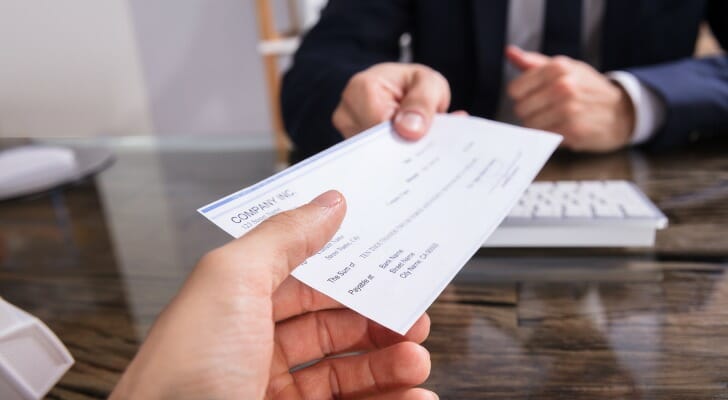There are a few options when you need a secure way of paying for something. Sure, cash is king, but not everyone feels safe carrying a thick wad of bills around. Cashier’s checks and money orders are two of the more secure options for making a payment. Each comes with its own set of advantages and disadvantages. First, it’s important to understand the differences between cashier’s checks vs. money orders before diving into their individual pros and cons.
Consider working with a financial advisor as you decide where to put your money.
What’s a Cashier’s Check?
A cashier’s check is a check issued and guaranteed by a bank or credit union. Unlike a personal check, a cashier’s check comes directly out of the bank’s funds instead of your checking account. These checks are more secure than personal checks for both parties as they are fully backed by the bank. That makes them great for large purchases, such as closing costs on a house or buying a car.
To get a cashier’s check, you’ll need the exact amount, your ID and the recipient’s name. You’ll be able to order one at your local branch or potentially online. You’ll need to pay the bank the amount of the cashier’s check, plus whatever fees they may charge.
Cashier’s check fees may be discounted or waived for certain accountholders. If you do a lot of business with a bank or credit union, it doesn’t hurt to ask.
Lastly, get a receipt as proof of purchasing the check. You’ll be able to use your receipt to track when the check is cashed.
Pros of Cashier’s Checks
- Great for large purchases: Cashier’s checks are best used for purchases over $1,000.
- More secure than money orders: Cashier’s checks generally have more security features than money orders. And, while there are cashier’s check scams, there are fewer compared to money orders.
Cons of Cashier’s Checks
- Higher fees than a money order: A cashier’s check can cost between two and 10 times more than a money order.
- Must have access to a financial institution that will write your check: This can be a problem if you don’t have a checking account, have recently moved or are on vacation.
What’s a Money Order?
Like a personal check, a money order is a paper certificate. However, instead of being backed by your bank account, it’s guaranteed by the company or organization that issues it. This makes it a more secure way of payment than a personal check.
You can get a money order at a variety of places. One big issuer of money orders is the United States Postal Service (USPS), but many grocery stores, pharmacies, check-cashing businesses and banks also offer them. Money orders are typically capped at $1,000 or less.
To fill out a money order you’ll need many of the same details as a cashier’s check: the amount, the recipient’s name and your ID. Remember to keep the receipt, and use it to monitor when the money order was cashed.
Pros of Money Orders
- Lower fees: Money order fees are often between $1 and $5 each.
- No access to financial institutions needed: If you don’t have a bank or your bank branch isn’t nearby, you can still easily get a money order.
Cons of Money Orders
- Not ideal for large purchases: Money orders max out at $1,000, so anything over that will require multiple money orders.
- Not as secure as cashier’s checks: Money orders have fewer security features than cashier’s checks and are more susceptible to scams.
Cashier’s Check vs. Money Order: What’s the Difference?

There are several differences between cashier’s checks vs. money orders.
- Where you purchase them: Cashier’s checks are issued and purchased at banks or credit unions where you’re a member. Money orders are far more accessible, as they can be purchased at stores, post offices and banks.
- Who backs it: Cashier’s checks are backed by the financial institution that issued them. Money orders are backed by the retail store, bank or post office where they were purchased.
- Fees: Cashier’s checks cost $10 or more to purchase, whereas money orders can be purchased for as little as $1.
- Size of purchase: Money orders often have a purchase limit of $1,000 or less. Cashier’s checks generally don’t have an upper limit.
Where to Track and Cancel a Lost Payment
If a cashier’s check or money order is lost, stolen, or goes uncashed, it’s important to know how to trace and possibly cancel the payment. For cashier’s checks, you’ll need to contact the issuing bank and provide a copy of the original receipt. The bank may require a declaration of loss and could impose a waiting period—sometimes up to 90 days—before refunding or reissuing the check to protect against duplicate claims.
For money orders, you can typically initiate a tracking request through the issuer—such as USPS, Western Union or MoneyGram—using the original receipt or tracking number. Most issuers charge a nonrefundable fee to start the process and may take several weeks to complete the investigation. If the money order hasn’t been cashed, a replacement or refund may be issued.
Because the ability to stop or replace these payments depends heavily on the issuer’s policies and whether the document has been cashed, it’s essential to keep your receipt and act quickly. Without proper documentation, recovering lost funds can be difficult or impossible.
How to Avoid Scams With Cashier’s Checks and Money Orders
Though cashier’s checks and money orders are often seen as secure, both can be exploited in scams. Fraudsters may use counterfeit versions to convince someone to release goods or send money before the payment has actually cleared. One way to protect yourself is to confirm a cashier’s check with the issuing bank before completing the transaction, especially when dealing with someone you don’t know.
With money orders, look for tampering, such as smudged ink or altered amounts. If the money order was issued by the U.S. Postal Service, you can use their tools to check if it’s valid. Be wary of transactions where you’re asked to deposit a money order for more than the purchase price and return the difference—that’s a common red flag.
If anything about the payment or the person offering it seems questionable, take extra precautions. Using a secure payment method or asking your bank for advice can help you avoid losing money to fraud.
Which Should You Use and When?
Cashier’s checks and money orders are two types of secure payment options. Both are suitable when you don’t want to carry around a briefcase full of money or the person you’re paying doesn’t want to risk bouncing a check.
How much money a person needs and whether they have access to a bank account will dictate whether a cashier’s check or money order is best. Cashier’s checks, which require a bank account, are for large payments of more than $1,000. While money orders are available in more places and do not require a bank account, they’re limited to purchases of $1,000 or less.
So, if you need to put a down payment on a house, go to your bank and get a cashier’s check. However, if you’re buying an $800 antique lamp off Craigslist while on vacation, use a money order.
Bottom Line

When comparing cashier’s checks vs. money orders, it’s clear that each has its purpose. You can get a money order at many more places than a cashier’s check. They’re cheaper and don’t require a bank account. However, cashier’s checks are more secure and are perfect for large purchases or payments.
You can consider working with a financial advisor to manage your finances and develop a financial strategy moving forward.
Tips for Big Spending
- If you’re considering making a big purchase and need some unbiased advice, look into finding a financial advisor. They’ll be able to guide you in what to do and whether the purchase makes sense for you. Finding a qualified financial advisor doesn’t have to be hard. SmartAsset’s free tool matches you with financial advisors who serve your area. You can interview your advisor matches at no cost to decide which one is right for you. If you’re ready to find an advisor who can help you achieve your financial goals, get started now.
- Maybe you’re not ready to spend yet, but you have things you want to save for. SmartAsset’s savings calculator can help you get there. Whether it’s a down payment on a house, a vacation or just building your emergency savings, it’s always a good time to save.
Photo credit: ©iStock.com/AndreyPopov, ©iStock.com/simonkr, ©iStock.com/AsiaVision
